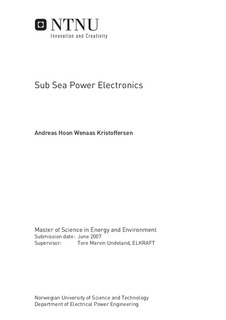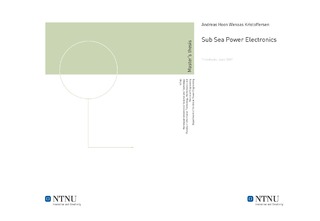| dc.contributor.advisor | Undeland, Tore Marvin | nb_NO |
| dc.contributor.author | Kristoffersen, Andreas Hoon Wenaas | nb_NO |
| dc.date.accessioned | 2014-12-19T13:51:08Z | |
| dc.date.available | 2014-12-19T13:51:08Z | |
| dc.date.created | 2010-09-04 | nb_NO |
| dc.date.issued | 2007 | nb_NO |
| dc.identifier | 348475 | nb_NO |
| dc.identifier | ntnudaim:3509 | nb_NO |
| dc.identifier.uri | http://hdl.handle.net/11250/256567 | |
| dc.description.abstract | Sub sea compression for maintaining reservoir pressure in a gas field is important to have a steady production of gas as it is extracted from the field. Electrical drives in the several megawatt range are suitable to control the compressor motor since it is not desirable to have gears which need maintenance. Problems related to the location on the sea bed have so far been overcome by using massive pressure tanks which hold 1 atmosphere. A new approach would be to allow the pressure on the sea bed to be applied on the electrical components. This will reduce and simplify the system only needing a thin walled casing filled with oil to contain the electronics, but the electronic components then need to be compatible with the oil and function at high hydrostatic pressure. This report include suitable electrical power systems for a compression application, theory around the most likely to be used switch, some available modules and an experimental set up for testing IGBT compatibility with oil. Converters consisting of rectifiers and inverters are widely used in industrial motor drives and it is assumed that such a converter will be used consisting of a diode bridge rectifier and a neutral point clamped inverter. High voltage applications often operate with voltages above the rated value of many semiconductor components which means that switches must be series connected. A neutral point clamped inverter with series connected switches will be able to handle the high voltages and produce a good spectral output to the motor terminals. The switches used in the inverter will probably be IGBTs. The IGBT evolved as the most successful device for high power, high switching frequency applications blending MOSFET switching capabilities with BJT on-state conduction properties. Development has produced a lot of versions of this kind of switch, and by modifying doping profiles and geometrical properties a set of devices with improved characteristics has been made. Packaging techniques make it possible to integrate the switches in different environments. Examples are the press pack modules which can be hermetically sealed and the standard DBC solutions. To test compatibility with insulating oil, an experiment was set up. An IGBT inverter leg module was placed inside a tank which was filled with oil. The module was operated in an H-bridge configuration with another bridge leg on the outside of the tank. Thorough testing before submerging it was performed to ensure and document normal behaviour. When fully submerged the module was tested and the results compared with those from the initial testing. Short duration of continuous switching was also performed followed by intermittent operation with current pulses and long term continuous switching. None of the captured scope pictures or temperature measurements showed deviation from normal IGBT behaviour or change of characteristics. It can then be concluded that when submerging an IGBT module in insulating oil, no instant failure or change of electrical behaviour occurs. | nb_NO |
| dc.language | eng | nb_NO |
| dc.publisher | Institutt for elkraftteknikk | nb_NO |
| dc.subject | ntnudaim | no_NO |
| dc.subject | SIE5 energi og miljø | no_NO |
| dc.subject | Elektrisk energiteknikk | no_NO |
| dc.title | Sub Sea Power Electronics | nb_NO |
| dc.type | Master thesis | nb_NO |
| dc.source.pagenumber | 87 | nb_NO |
| dc.contributor.department | Norges teknisk-naturvitenskapelige universitet, Fakultet for informasjonsteknologi, matematikk og elektroteknikk, Institutt for elkraftteknikk | nb_NO |

